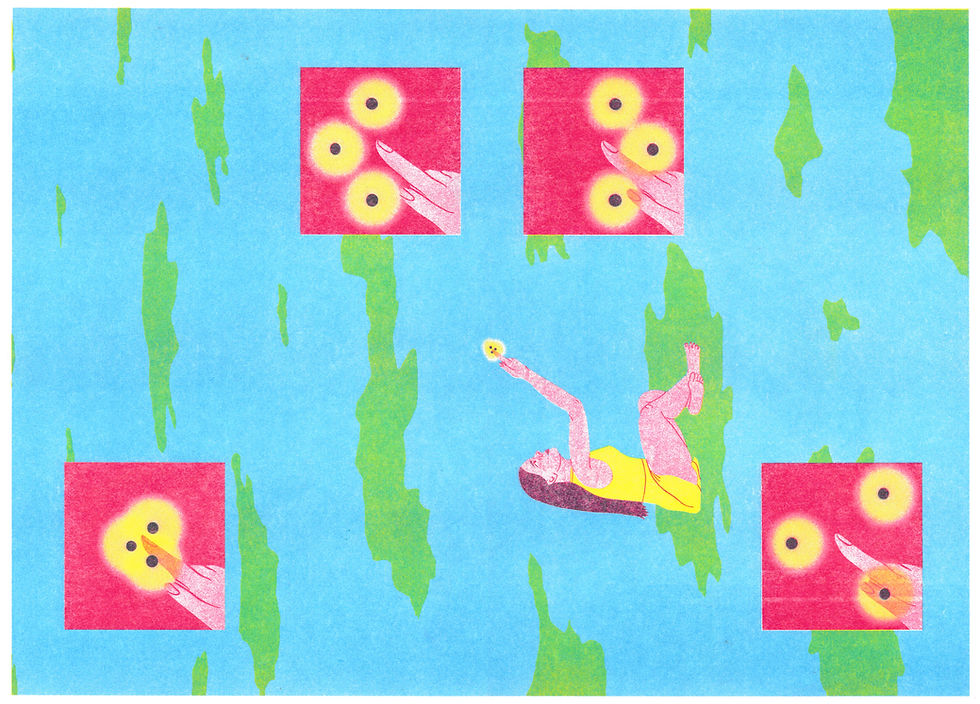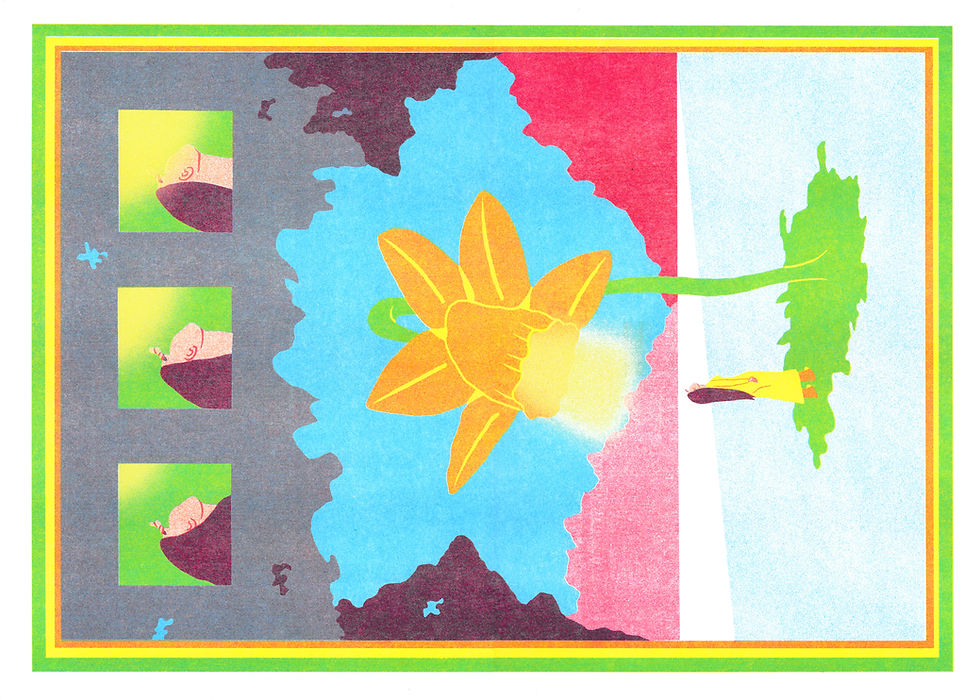Cassady Moll
- Anna Lilli Garai
- Jun 25
- 5 min read
Cassady Moll’s work is shaped by a sensitivity to atmosphere and memory. Working primarily with risograph printing, she builds quiet, layered images that reflect on place, rhythm, and personal connection. Originally from the U.S. and now based in Amsterdam, her practice unfolds slowly, often guided by intuition and close observation. Her images often feel like snapshots of a moment. There is a calm and steady pace to the way she works.

Q: What stayed with you from growing up in different parts of the U.S.?
A: The U.S. is a massive place, which I think a lot of people from outside North America understand conceptually, but maybe not literally. The scale is hard to grasp if you didn’t grow up there. I don’t think I even fully understood it until I left and came back. Going from one area of the country to another is really like traveling between different countries, culture-wise. The language is the same, of course, but even then, there’s a lot of variance in accents and even dialects.
That said, moving to all these different areas really made me appreciate the diversity of my country, both in terms of people and landscapes. I think it turned me into a very curious kid—asking a million questions, always wanting to know more. The impermanence of relationships and environments became an apparent fact of life to me at a very young age, so I wanted to gather as much information as I could before we inevitably moved on to the next place. Where did this person come from? What was the food like there? Were there mountains, lots of trees? Did it have the kind of rain that’s big and wet and slaps you in the face, or the kind that drizzles and sits on your skin? Did it rain at all?
Q: Do you remember the last small moment that made you want to pause?
A: I live in Amsterdam now, so like most people here, I cycle pretty much everywhere I need to go. I notice many things on these bike rides that make me want to pause: the wind catching someone’s umbrella and pulling it inside out, the sound of a loose bike chain making a squeaking noise that sounds like some kind of animal, the smell of wisteria and elderflower.
The most recent moment I can think of, though, was on a longer bike ride I took to IJburg. I hadn’t been in a while, and I don’t usually go that far east in my day-to-day life. There’s this moment where you come out of a little path that runs through the Science Park and onto the Nescio Bridge that always feels really refreshing and exhilarating to me.
I had forgotten about that feeling and had a moment of very pure tranquility and joy—it reminded me how lucky I am to be here, and that I have the choice to stay here, if I want.
These moments are a nice but firm reminder that it’s important to take stock of the things around me, even when they become mundane and routine. I think that’s what my process revolves around, really: taking stock of things.

Q: Is that balance of calm and tension in your work something you feel in everyday life too?
A: I think to a less exaggerated extent, yes. I’m very aware of the fleeting nature of things, probably to my own detriment.
That’s not to say that things always permanently go away when you leave them—more that, for me, it’s hard not to notice a moment passing as it’s passing, if that makes sense. There’s tension in calmness because calmness, like any other feeling, is ephemeral.
With my work, I’m essentially attempting to bend, stretch, and pause time as much as possible, which is beautiful—but also a bit sinister and odd.
Q: What drew you to risograph printing in the first place?
A: Risograph printing is a method I first got curious about when I went to the San Francisco Zine Festival back in 2019. I was immediately captivated by the super saturated colors, how they blended together, the texture that was being achieved. Back then, I was just starting to explore environments in my work that were a bit more abstract, but I hadn’t really found a way to achieve this that resonated with me. Seeing those risograph-printed pieces for the first time felt like the answer I had been searching for.
Unfortunately, the pandemic happened shortly after that, so most of my early risograph experiments were done with emulator brushes that replicated the final result digitally without needing a physical risograph printer.
I wasn’t satisfied with this, so I dropped the technique for a while, but picked it back up again in 2022 when I could print in person and get familiar with the machine and how it functions.
Once I got to that stage, I was really able to nail down the technique, and now I return to it often in my projects.
I gravitate towards it because the process and results tend to mirror the themes I explore—the colors are often amplified and have an otherworldly quality to them, and the printing process itself forces you to pause and assess things as you go.


Q: How do you usually know when to stop working on a piece?
A: This is always such an interesting question. For me, the work is done when the tone feels correct. Above all else, I’m very particular about the emotional response that comes from my pieces, so I’m usually aware when something feels “off.” I know how I want a piece to make me feel, essentially—so if it’s not evoking that response in me, I know I probably need to keep working.
Mechanically, this typically means putting my materials down, taking a step back, and trying to identify where the “wrong-ness” is coming from. I’m quite a fast worker and like to get ideas down quickly, so if the “wrong-ness” is something I’m having trouble identifying, I usually just scrap the piece and restart. I’ll repeat this process until I feel like I’ve exhausted all avenues with an idea—then I stop.

Q: Has living in Amsterdam changed how you look at things, visually or otherwise?
A: It absolutely has. Things operate in quite an efficient and direct manner here, which impacts my day-to-day life, and of course affects my practice and work. I find the way efficiency is approached in the Netherlands to be interesting because it seems tied to people wanting as much downtime and free time as possible—time to sit and have a gezellig night with friends, time to cook a meal at home, time to just do nothing. There’s a boldness to that, and I admire it a lot.
My interests tend to lie in the magic of those free and “nothing” moments, so moving here only amplified my appreciation of them. I think the candid nature of communication here also increased my desire to make my pieces clear and uncluttered—exaggerated, bright, and strange, absolutely, but not messy or haphazard.
In terms of the city itself, Amsterdam is very international, so I get to interact with people from around the world on a daily basis, which feeds my curiosity in a way I find endlessly inspiring. It’s a very transient place, with people always coming and going, so I feel a deep kinship with it—everyone from everywhere is existing here, at least for a moment.


